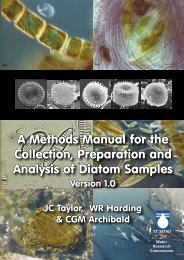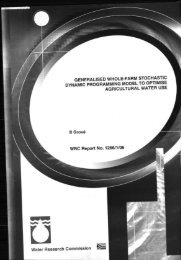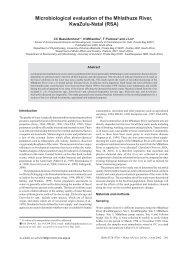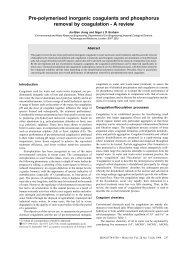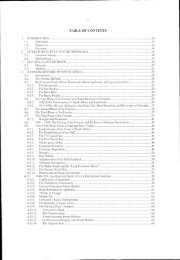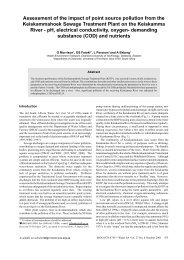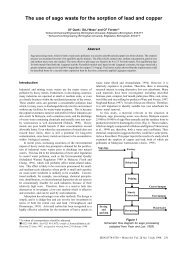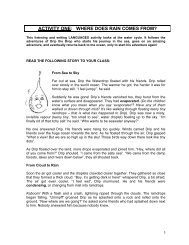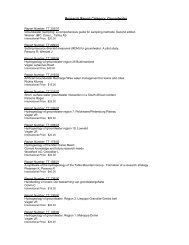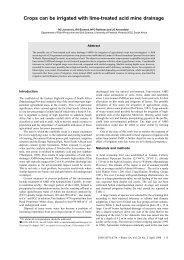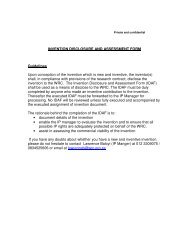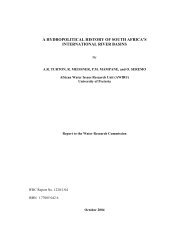and the Efficacy of Pit Latrine Additives - Water Research Commission
and the Efficacy of Pit Latrine Additives - Water Research Commission
and the Efficacy of Pit Latrine Additives - Water Research Commission
- No tags were found...
You also want an ePaper? Increase the reach of your titles
YUMPU automatically turns print PDFs into web optimized ePapers that Google loves.
Complete chemical characterisation <strong>of</strong> this material was not performed due to time constraints. However<br />
moisture content was determined <strong>and</strong> found to be 76%.<br />
3.2 Gas production from each experimental batch: Set 1<br />
80.00<br />
60.00<br />
40.00<br />
Volume <strong>of</strong> gas<br />
produced<br />
(Nml/gCOD)<br />
%<br />
moisture<br />
(g H 2 O/ g<br />
sample)<br />
76<br />
82<br />
86<br />
88<br />
90<br />
91<br />
0 1.8 3.6 5.4 7.2 9<br />
Amount <strong>of</strong> alkalinity added (mg NaHCO 3 / g dried solid)<br />
20.00<br />
0.00<br />
Figure AB.7: Cumulative gas production results after 36 days for experiment Set 2 showing<br />
dependence <strong>of</strong> gas production on additional moisture <strong>and</strong> alkalinity.<br />
Figure AB.7 presents cumulative gas production after 36 days in matrix form to show <strong>the</strong> effect <strong>of</strong> increasing<br />
moisture <strong>and</strong> alkalinity on gas production. Note that <strong>the</strong> scale on <strong>the</strong> vertical axis <strong>of</strong> Figure AB.7 is much<br />
larger than that <strong>of</strong> Figure AB.4 due to <strong>the</strong> much higher gas production rates. Figure AB.7 shows that <strong>the</strong><br />
control bottles (i.e. no moisture or alkalinity added) produced virtually no gas. In contrast, all o<strong>the</strong>r<br />
experimental bottles produced significant amounts <strong>of</strong> gas. Clearly, according to <strong>the</strong>se results, <strong>the</strong> addition <strong>of</strong><br />
water had a significant effect on <strong>the</strong> gas production rate.<br />
The data from Set 2 did not support <strong>the</strong> hypo<strong>the</strong>sis that <strong>the</strong> addition <strong>of</strong> alkalinity had any effect on <strong>the</strong> gas<br />
production rate (ei<strong>the</strong>r positive or negative). However, regression analysis showed that <strong>the</strong>re was a<br />
significant relationship between <strong>the</strong> rate <strong>of</strong> gas production <strong>and</strong> <strong>the</strong> moisture content 23 . However, only 10% <strong>of</strong><br />
<strong>the</strong> variation observed in <strong>the</strong> data can be explained by <strong>the</strong> moisture content (R 2 = 0.097); i.e. 90% was due<br />
to unmeasured factors such as <strong>the</strong> variation in biodegradability <strong>of</strong> <strong>the</strong> pit latrine contents due to its nonhomogeneous<br />
nature. The regression predicted that <strong>the</strong> rate <strong>of</strong> gas production increased by a rate <strong>of</strong><br />
between 0.006 <strong>and</strong> 0.02 ml gas/g total solids/day per 1% increase in moisture content.<br />
23<br />
Significance <strong>of</strong> regression = 0.002 < 0.05 <strong>the</strong>refore it is a 95% probability that increased moisture content causes an increase in gas<br />
production<br />
87



